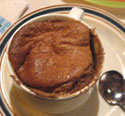
Chocolate Blogs
 Jan 25, 2018
Jan 25, 2018
Making Sikwate: from cacao fruit to a hot dark chocolate drink
Location: Lyn's Backpacker Inn, Loboc (municipality), Bohol (province), Philippines
Glossary
- cacao - chocolate fruit hanging off a tree
- tablea - pure dark chocolate block
- sikwate - hot dark chocolate drink
Sikwate
I'm a big sikwate fan and it gives me great joy to be introduced to the making of the sikwate - a hot dark chocolate drink that has been part of the Filipino tradition since the Spanish times. Rare and highly prized in Europe and North America, it is ironic that it has remained a poor man's morning drink in the wet markets of the Philippines. However, it has been trending lately with its introduction into polite society's proper cafe scene.
Spanish Cacao
Bohol is a source of the Spanish variety of cacao that commands a high price in the global market. This tree is hardy, grows big and survives for decades, bearing small and hard cacao beans. The Spanish trees still exist but usually inside residential compounds or in the forest as one-off trees. I am not aware of any production scale of the Spanish variety cacao. In contrast, the popular grafted hybrid does not get too tall, bears big fruits but only for about a decade before the tree flounders.
 Lyn's Backpackers Inn
Lyn's Backpackers Inn
Here at Lyn's Backpackers Inn, run by the Huerte family, the surrounding land is rich in their produce - cacao (Spanish variety), herbs, rice, chickens, etc. As I resumed my short-term residency, I came upon their trusted hand, simply known as "Bossing" whom I chanced on roasting cacao. I interviewed him about the process and even helped out removing the skin from the roasted cacao. Meticulously, he took me along the steps from cacao fruit to the sikwate drink.

Making of Sikwate from Cacao
- fruit picking - ripe yellow cacao fruit is picked from the tree. The fruit is halved and kids suck the sweet nectar from the seed like they would the santol
- drying - the seeds are then washed and left to dry in the sun
- roasting - the dried seeds are then dry-roasted for about an hour while stirring constantly to prevent burning. If buying dry seeds in the market, the price is about P190/kilo in Tagbilaran and about P175/kilo in Ubay
- skinning - after roasting, when the seeds are not too hot, the skin is crushed-off from the seed and the seed is separated from the rest. Often, the entire seed breaks and the skin blends in with the crushed seed. This section is separated as well in a bilao, where it is threshed. If roasted and de-skinned cacao seed is bought from the market, the price is about P500/kilo.
- threshing - the bilao is then threshed to separate the crushed skin from the crushed seeds, similar to the way brown husk is separated from the white rice. Usually, a light breeze is needed to blow the crushed skin away. The remaining crushed seed is now joined with the whole seeds for grinding
- grinding - the batch is then ground similar to peanuts being ground to make peanut butter. The ground cacao seed has the consistency of melted chocolate. It's runny and gooey unlike peanut butter which is pasty. There is no grinder facility in Loboc, so the batch is sent to the neighboring town of Loay for grinding. Grinding is P18/kilo.
- semi hardening - ground cocoa is allowed to cool and semi-harden to be shaped into tableya
- shaping into Tableya - when the ground cocoa has semi-hardened and can be worked-on, it is put inside a polvoron presser/shaper to assume a circular form - about 1.5 inches in diameter and about 4mm thick. This is now called Tableya and is usually sold in the market as-is, packaged in a variety of weights. This can now be stored for future use. Tableya can also be used to make champorado (chocolate rice porridge).
- sikwate - water is boiled and the Tableya added into it and whisked for a frothy finish. Put as much Tableya for the desired chocolate strength and pour into a cup - that beverage is now called sikwate - pure native hot dark chocolate drink.
- serving - sikwate is traditionally served in the morning paired with puto-maya (sticky rice cooked in coconut milk)
Sikwate in Proper Cafes
Sorry to have strung you along, but sikwate at Lyn's is only for their family consumption - perhaps in the near future, it would be available if my persuasive power prevails :) In the meantime, you can enjoy sikwate in the following proper cafes:
- Loboc - Fox and Firefly Cottages (P120) and at Sapa (P15)
- Baclayon - Crescencia Food & Coffee (P50 with Boras on the side)
- Tagbilaran - Country Cafe (P50), Caffeine (P70), Tableya de Maria Clara (P80 for espeso) and Tamper Coffee & Brunch (P110).
Ending Thoughts
I'm also a coffee fan, but if it's a choice, I would choose sikwate hands down over coffee. I add a little bit of rum and thick heavy cream for a richer texture. In the ancient Mayan culture, it is said that chocolate was food for the gods. Drinking pure sikwate delights the divine residing within you.
--- TheLoneRider
YOGA by Gigit ![]() |
Learn English
|
Learn English ![]() |
Travel like a Nomad
|
Travel like a Nomad ![]() |
Donation Bank
|
Donation Bank ![]()
Making of sikwate from cacao in pictures
Leave a comment?
Reader Comments:
 Brenda
Brenda (Jan 28, 2018) Yummy! Is there no sweetener added?
(Jan 25, 2018) ...my dear Brenda, what a pleasant surprise! No sugar or sweetener whatsoever is added to tableya (100% pure dark chocolate block), unless specified by other commercial vendors. You can add your sweetener though once you make a sikwate drink from the tableya.
(Jan 25, 2018) People of North America are much more appreciative of bitter, roasty flavours. Everything is sweetened here. Thanks for showing the whole process of creation.
 Alex
Alex Lyconet Americas
(Jan 28, 2018) Turuan mo ko, Git (Teach me, Git)
 Aravis Sat
Aravis Sat(Jan 2018) I wonder if any cacao grower in Bohol ferments their beans? That's an essential step in developing the chocolate flavor.
Next story:

![]()

![]()
Bruschetta: Nawa Saraan Style
(Apr 22, 2019) Bruschetta is a long held Italian tradition - plum tomatoes, olive oil, basil, garlic and baguette. But here at the Nawa Saraan kitchen, things are done with a little flair for innovation....more »»
Related Bohol Coffee/Cacao Links:
- Cacao Drum Roasting Jan 27, 2018
- Making Sikwate: from cacao fruit to a hot dark chocolate drink Jan 25, 2018
- Exploring the Cafe Scene of Tagbilaran Oct 7, 2017
- Chocolate Overload at Dalareich Chocolate House Oct 2, 2017
Loboc Map

Loboc, Bohol, Philippines
 Cruz Daku - 80-foot white cross erected in 1986 on top of Loboc's highest mountain
Cruz Daku - 80-foot white cross erected in 1986 on top of Loboc's highest mountain Virgen de Guadalupe - giant statue of the Black Madonna perched on a Loboc summit
Virgen de Guadalupe - giant statue of the Black Madonna perched on a Loboc summit River Cruise - river cruise on a floating restaurant serving lunch with cultural presentation
River Cruise - river cruise on a floating restaurant serving lunch with cultural presentation Busay Falls - accessible only through the river cruise
Busay Falls - accessible only through the river cruise Loktob Spring - cold water spring, free admission, huts for rent
Loktob Spring - cold water spring, free admission, huts for rent Zipline and Cable Car Ride - at the Eco-Tourism Adventure Park
Zipline and Cable Car Ride - at the Eco-Tourism Adventure Park
 Fox & The Firefly Cottages - SUP paddle boarding, luxury riverside native cottages, mountain bike tours, SUP yoga
Fox & The Firefly Cottages - SUP paddle boarding, luxury riverside native cottages, mountain bike tours, SUP yoga Lyn's Backpackers Inn - family-run guesthouse in the heart of Loboc
Lyn's Backpackers Inn - family-run guesthouse in the heart of Loboc
Bohol Travel Info/Tips
Bohol FYI / Tips
- the tourist area where most of the hotels, restaurants, ticket offices, tour operators are, is located within the Alona Beach area
- the tourist attractions in Bohol are far apart and spread-out. It would be difficult to visit them all using public mass transit. Better hire a van (P3500/day) if in a big group, or rent a motorcycle (P400/day + gas)
- Bohol relies on its tourism for revenue. As expected, everything they can capitalize on from tourism is extensively used and developed
Tagbilaran Port to Panglao
You can charter any tricycle from the port all the way to Panglao (~P300), but if you want to do it on the cheap,- don't take the tricycles lined-up inside the port. Walk past the port gate and immediately outside, you'll see many tricycles. Take one to the bus terminal in Dao (~P15)
- in Dao, take the jeep that plies the Panglao route (~P20)
Tagbilaran (Bohol) to Cebu City by boat
** schedules and rates keep changing, call for latest schedule- Weesam Express - departs 6:15 AM, 11:30 AM, 4:00 PM
one way: Economy (aircon) P500.00, Economy (non-aircon) P400.00, First Class P600.00
round trip promo (at least 2 days advance booking): Economy (aircon) P600, Economy(non-aircon) P500, First Class P1200
round trip promo (1 day or on the day booking): Economy (aircon) P800, Economy (non-aircon) P700, First Class P1200 - Ocean Jet - departs 6-7:05-8:20-9:20-11:40AM, 1-2-3:30-4:20-5:30-6:30PM, 2 hours, arrives Pier 1 in Cebu
Open Air / Tourist Class P800, Business Class P1000
+63(32)255 7560 / +63 (32) 255 0115 / 0917 638 0000 - SuperCat (2GO) - departs 5:50-11AM, 3:45-5:25-8:15PM, arrives Pier 1 in Cebu
P 500.00
+63 32 233 7000
Things to do, Places to go in Bohol
- Chocolate Hills - this is a clustering of more than 1200 hills within a 50km2 area. They range in height from 30-50 meters. What's unusual is their near-perfect conical shape resembling an individual chocolate chip. No one knows how they were formed. Entrance is P50/pax.
- Tarsier Conservation Area - located Upper Bonbon, Loboc. The tarsiers are no longer being played at by tourists as circus props, but instead, visitors now view them in cordoned-off areas in their natural 6ha habitat. As they are territorial and nocturnal, they are predictable on where they can be viewed. P50/pax.
- Alona Beach (Panglao) - Alona Beach is the tourist hub of Bohol. It has 1.5 kms of white sand beach lined-up by bars, hotels and restos. Alona is also the jump-off point for Balicasag Island, a world class dive destination.
- Danao Adventure Park - located in Barangay Magtangtang, 72 kms (2 hours ride) from Tagbilaran. Adventure activities include river trekking, tyrolean traverse, rappelling, bouldering, rock climbing and ziplining.
Currency Converter
»» next story: Cacao Drum Roasting
»» next Food Recipes story: Bruschetta: Nawa Saraan Style
»» back to Food Recipes
»» back to Homepage
ARCHIVE 2025:
JAN |
FEB |
MAR
1970 |
1973 |
1975 |
1976 |
1979 |
1981 |
1996 |
2000 |
2001 |
2002 |
2003 |
2004 |
2005 |
2006 |
2007 |
2008 |
2009 |
2010 |
2011 |
2012 |
2013 |
2014 |
2015 |
2016 |
2017 |
2018 |
2019 |
2020 |
2021 |
2022 |
2023 |
2024 |
2025 |
ALL BLOGS







